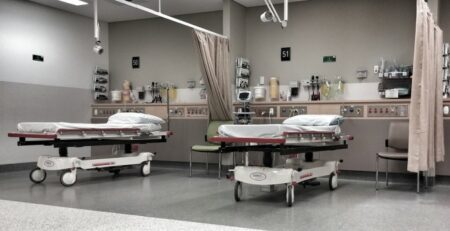7 Data-Backed Signs Your Hospital Is Ready for Expansion
Expanding a hospital is a monumental decision—one that can either solidify your institution’s legacy or lead to financial ruin.
Many hospital owners fall into the trap of expanding either too early, before their systems are ready, or too late, when opportunities have already slipped away. Both mistakes can cost millions, and in some cases, the hospital itself. I learned this the hard way when I expanded my own hospital at the wrong time and nearly lost everything.
The reality is that hospital expansion isn’t about ego, outshining competitors, or keeping up with the larger players in your city. It’s about addressing a genuine need for your community—more patients, better care, stronger systems—while ensuring your finances, staff, and infrastructure can support the growth.
So, how do you know when the timing is right? Below are seven unmistakable signs that your hospital is ready to expand, along with insights to help you avoid the pitfalls that could derail your plans.
| 7 Signs | Readiness Benchmark | Quick Action |
|---|---|---|
| High occupancy | >85% for 6+ months | Start feasibility study |
| Patients turned away | Weekly redirects | Expand capacity or new facility planning |
| Long wait times | Above industry average | Add staff or streamline process |
| Staff burnout | High overtime or turnover | Redistribute workload; hire support |
| Strong cash reserve | 12–18 months’ ops expenses | Safe to consider capex |
| Outgrown facility | No space for new services | Evaluate expansion or relocation |
| Healthy profit margins | EBITDA >15% | Proceed with risk-controlled scaling |
Let’s understand these 7 Signs For Hospital Expansion in more details:
1. Your Occupancy Rate Stays Above 85% for 6+ Months
Empty hospital beds mean lost revenue, but consistently full beds signal something far more significant: sustained demand. If your hospital’s occupancy rate has been above 85% for at least six months, you’re not just experiencing a seasonal surge—you’re seeing a clear indicator that your community needs more from you.
High occupancy rates show that patients trust your hospital and rely on your services. This isn’t just about filling beds; it’s about recognizing that your current capacity is limiting your ability to serve. Before you expand, analyze your occupancy data to confirm that this trend is consistent. A six-month period of high occupancy rules out temporary spikes and confirms that demand is real and ongoing.
Key takeaway: If occupancy stays above 85% for more than six months, it’s time to begin a capacity feasibility study and plan for controlled expansion.
2. You’re Turning Patients Away Weekly
Every time you turn a patient away, you’re not just losing revenue—you’re eroding the trust your community has in your hospital. If your facility is regularly redirecting patients to other hospitals due to lack of space or resources, it’s a red flag that your current setup can’t keep up with demand. Turning away patients is a delayed indicator of demand strain and system inflexibility.
Track how often you’re turning patients away. Are you redirecting a handful of patients each week, or is it a daily occurrence? If it’s happening regularly, expansion isn’t a luxury—it’s a necessity to maintain your hospital’s reputation and fulfil your mission to serve the community. Expanding your capacity can help you say “yes” to more patients, boosting both your revenue and your standing in the community.
Key takeaway: Regularly redirecting or refusing patients signals capacity failure — expansion isn’t optional, it’s urgent.
3. Waiting Times Exceed Industry Standards
In healthcare, time is critical. Patients expect prompt care, and excessive waiting times can drive them to competitors who can see them faster. If your hospital’s average wait times for appointments, emergency services, or procedures consistently exceed industry benchmarks, it’s a sign that your capacity is stretched to its limits.
Compare your wait times to industry standards, such as those set by organizations like the American Hospital Association or local healthcare regulators. For example, if the standard emergency room wait time is 30 minutes but your patients are waiting an hour or more, you’re losing ground to competitors. Expansion—whether through additional staff, beds, or facilities—can help you reduce wait times and keep patients coming back.
Key takeaway: When patient wait times surpass industry benchmarks, add staff or space before competitors absorb your unmet demand.
4. Your Staff Is Burning Out
Your doctors, nurses, and support staff are the backbone of your hospital. If they’re working overtime week after week to keep up with patient demand, they’re at risk of burnout. Overworked staff are more likely to make mistakes, which can harm patients, damage your hospital’s reputation, and lead to costly legal issues.
“We found that physicians with burnout had more than twice the odds of self-reported medical error …”
— Tawfik et al. (Stanford / JAMA study)
“Burnout among our health care team members is often caused by the failure of health care leaders to evolve … to advance their mindsets, management methods and systems.”
— Sarah Patterson, Virginia Mason Institute
Burnout isn’t just a staffing problem—it’s a sign that your hospital’s current capacity can’t sustain its workload. Expansion isn’t only about adding beds or square footage; it’s about creating a sustainable environment where your staff can thrive. Adding more resources, such as hiring additional personnel or opening new departments, can alleviate the pressure on your team and ensure they can continue delivering high-quality care.
Key takeaway: Persistent staff burnout means your hospital’s workload has outgrown its systems — invest in expansion or additional resources before quality drops.
5. You Have a 12–18 Month Cash Reserve
Expansion is a massive financial undertaking, and underestimating the costs can be catastrophic. Construction, new equipment, additional staff, and unexpected delays all eat through cash reserves faster than most owners anticipate. If you don’t have at least 12 to 18 months’ worth of operating expenses saved, you’re taking a dangerous gamble with your hospital’s future.
Before you even consider breaking ground, conduct a thorough financial audit. Ensure your cash reserves are robust enough to cover not only the costs of expansion but also any unforeseen challenges, such as delays in construction or dips in revenue during the transition. Smart hospital owners prioritize financial stability, saving first and building second.
Key takeaway: Hold at least 12–18 months of operating reserves before expansion — it’s your safety net for construction delays and revenue dips.
6. Your Current Location Has Hit Maximum Capacity
There’s a hard limit to how much you can grow within your existing facility. You can’t keep adding beds, equipment, or staff to a building that’s already at its physical limits. If you’ve run out of space for new departments, additional beds, or even parking, your current location is holding you back.
When space becomes your biggest constraint, expansion—or even relocating to a new facility—becomes the only viable path forward for hospital capacity planning. Evaluate your current infrastructure to determine whether you can renovate or reconfigure existing spaces to meet demand. If not, it’s time to start planning for a larger facility or an additional location.
Key takeaway: When your existing space can’t fit new beds, departments, or parking, expansion or relocation becomes the only sustainable growth path.
7. Your Profit Margins Are Healthy and Stable
Expanding a struggling hospital is like pouring water into a leaky bucket—it won’t fix the underlying problems, and it might make them worse. If your hospital’s EBITDA (Earnings Before Interest, Taxes, Depreciation, and Amortization) margins are consistently above 15%, you have the financial foundation to scale safely.
Healthy profit margins indicate that your hospital is operating efficiently and generating enough revenue to absorb the costs of expansion. Before moving forward, review your financial statements for at least the past two years to ensure your margins are stable. If your hospital is barely breaking even, focus on fixing operational inefficiencies before considering growth.
Key takeaway: Consistent EBITDA margins above 15% show financial readiness — expand only when profitability and efficiency are steady for at least two years.
What Most Hospital Owners Get Wrong
One of the biggest mistakes I see hospital owners make is expanding because their competitors are doing it. This isn’t a strategy—it’s a reaction driven by fear or ego. Expanding to “keep up” with the hospital across town or to boost your own prestige is a recipe for disaster. Fear-driven growth often leads to over-leveraging, poor planning, and, in the worst cases, bankruptcy.
Your expansion should never be about matching your competitors or chasing superficial milestones. It should be about addressing a real need in your community—more patients, better care, stronger systems. Before you commit to expansion, ask yourself: Is this about serving more patients, or is it about feeling bigger? The answer will determine whether your growth is sustainable or a costly mistake.
Expansion Isn’t About Size—It’s About Sustainability
When done right, hospital expansion doesn’t feel like a gamble—it feels like an inevitable step forward. The signs are clear:
- Patients demand it. Full beds, long waitlists, and frequent patient redirects show that your community needs more from you.
- Your numbers prove it. Stable profit margins and a healthy cash reserve give you the financial security to grow without risking collapse.
- Your staff can handle it. Strong systems and adequate resources ensure your team isn’t stretched beyond their limits.
Without these signs, expansion is just a dream that could turn into a nightmare. With them, it becomes a sustainable strategy that saves lives, creates jobs, and strengthens your hospital’s legacy.
In short
A hospital is ready to expand when
- Occupancy stays above 85% for six months.
- You’re turning patients away weekly.
- Wait times exceed benchmarks.
- Staff are burning out despite overtime.
- You hold 12–18 months’ cash reserves.
- Your facility is physically full.
- EBITDA margins exceed 15%.
Each signal means demand is real, finances are strong, and your systems can scale safely.
The Takeaway
Before you break ground on a new wing or sign a lease for a second location, pause and reflect. Ask yourself two critical questions:
- Am I expanding to serve more patients and meet a genuine need in my community?
- Or am I expanding just to feel bigger and keep up with the competition?
One answer will guide you toward sustainable growth that benefits your patients, your staff, and your hospital’s future. The other could cost you everything.
So, does your hospital show these seven signs? If it does, you’re ready to take the next step. If not, focus on building the foundation—financially, operationally, and culturally—that will make expansion not just possible, but inevitable.
What This Means For
For the CEO
Expansion is a strategic timing decision — it’s about legacy and sustainability, not competition. Use these seven signals to ensure your growth serves patient need, not ego.
For the CFO
Run sensitivity analyses on EBITDA, DSCR, and cash reserves before committing capital. Expansion should strengthen liquidity, not strain it.
For the COO / CMO
Evaluate operational readiness — throughput, staffing ratios, and patient safety metrics. If any of these are breaking, expansion must fix the system, not multiply its flaws.
For the Board
Treat expansion as a governance issue. Require evidence of sustained demand, financial stability, and a 3-year ROI model before approving capital expenditure.
Frequently Asked Questions
1. How do I know if my hospital is truly ready for expansion?
If your occupancy remains above 85%, patient demand consistently exceeds capacity, and your profit margins stay stable, those are reliable readiness indicators. Expansion becomes a matter of when, not if.
2. What financial cushion should a hospital maintain before expansion?
Most hospital finance experts recommend maintaining at least 12–18 months of operating expenses as a reserve before starting any major expansion or construction.
3. How does staff burnout affect hospital performance?
High burnout leads to increased medical errors, lower patient satisfaction, and higher turnover—clear signs your existing system is overstretched and needs capacity relief.
4. When is it better to renovate instead of building new?
If your infrastructure allows internal reconfiguration or vertical additions without disrupting critical operations, renovation can be a cost-effective first step. If you’ve maxed out space, relocation or new construction may be inevitable.
5. What KPIs should hospital leadership review before approving expansion?
Key metrics include occupancy rate (>85%), EBITDA margin (>15%), staff turnover, average wait time, and days of cash on hand. Consistent strength across these signals financial and operational readiness.








Leave a Reply